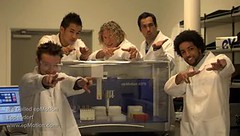For a decade, University Museums in Scotland (UMIS) have organized biennial conferences dealing with themes like cultural entitlement and museums (2006), the significance of collections (2004), the alleged ‘death of museums’ (2000), etc. (see all programmes here).
This year’s conference in Aberdeen (20-21 November 2008) will focus on ‘The Contentious Museum’ because, say the organisers, “museums have become increasingly contentious places”.
I couldn’t agree more. Museums are situated in a tumultous contemporary world with all sorts of new, potentially disruptive social, economic, religious and cultural conflict patterns, and many of these serious conflicts are pervasively permeating the museum world and the curatorial profession.
But these are apparently not the kind of contentious issues that the organizers think about. They rather want to engage with slavery, repatriation of objects, the treatment of human remains and so forth; they want to discuss “how responding to such challenges can enable museums to depart from tradition and embrace different ways of thinking, working and developing new audiences”. Thus the first conference day will focus on the display and curation of human remains and the legacy of empire and slavery (2007 was the bicentenary of the 1807 abolition of the slave trade); on the second day Galton and eugenics will be among the topics (see the program here)
I’m not questioning the importance of discussing different opinions about the place of human remains, repatriation, slavery and eugenics in museums. But not only are these throroughly discussed issues, museums today are also confronted with even more challenging social and cultural problems. A conference theme like ‘The Contentious Museum’ would be better served to focus on some of these too.
For example, the large-scale processes of globalisation and marketisation have divided many museums into warring camps. There are ‘old-fashioned’ collection curators who behave as if museums were still national, research-based institutions for the preservation and solemn display of the cultural heritage for the educated classes and knowledge-hungry students. And there are ‘progressive’ managers and communication specialists who listen to the siren calls of the global ‘experience economy’ and try to turn museums into tourist traps to boost visitor statistics.
Another example is Science Museum’s counterpart to the 2006 Danish satricial Muhammad drawing incident, only in reverse. The museum decided to cancel a public meeting with James D. Watson last autumn because it was afraid that his racist remarks in The Sunday Times a few days earlier would alienate its audience (see earlier post here). Everyone agreed that Watson was a fool, but the decision to cancel the meeting was highly contested, also within the museum itself. Like the Danish Muhammad case, the Watson affair raised timely questions about free speech vs. cultural responsibility.
True, one or two talks in Aberdeen seem to bring up major contemporary contested issues. For example Clara Arokiasamy will speak about “Racial inequalities, multiculturalism, cultural diversity in Britain today: Are museums safe places for such discourses?” (see her and other abstracts here). But otherwise, there is not much in the program that indicates that this 6th biennial UMIS-conference will be remembered as a particularly controversial meeting.




 (see it in the right context, and better resolution, on
(see it in the right context, and better resolution, on 
 Now at least two companies (
Now at least two companies (
 A profile is (says
A profile is (says